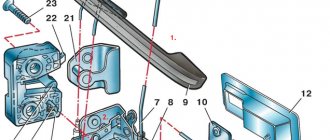The service life of the battery depends on its storage conditions. This is important if the car is not used in winter. Under no circumstances should you leave the battery in a car in the cold, as this leads to sulfation, destruction of the plates and loss of capacity. Therefore, you need to know how to store your battery at home correctly. Let's talk about this further.
Battery storage rules
If there is a need for long-term storage of batteries, they should be prepared accordingly. At any time you may need to install a battery in your car for a forced trip. So, preparation includes the following order of manipulations:
- We carry out an external inspection of the battery for damage and contamination, especially dust and oil.
- We clean the dirt with a rag soaked in alcohol, and separately clean the terminals dry.
- We check the capacity, as well as the level of electrolyte density.
- If the battery is serviceable, then add distilled water when its level drops.
- If necessary, we desulfate the plates, but this will require special equipment.
- We charge the device to the maximum.
There is another important point in the rules for storing car batteries. It would be useful to check the functionality of the entire electrical circuit: the condition of the wiring, spark plugs, starter, generator, etc. The purpose of such work is to detect places of abnormal current leakage. Otherwise, even a new and fully charged battery will quickly lose its capacity.
Conditions for saving the battery
The battery must be stored at positive temperatures. Optimal - at 10-12℃. Maximum allowed limit: 20℃.
It is important to avoid sudden temperature changes, as this will negatively affect battery performance.
A dark, cool, ventilated place is best for batteries. When exposed to sunlight, sealing gaskets lose their performance characteristics.
The device must not be turned over or placed horizontally. Place the device only on a level place, avoiding tilting to the side and changing the electrolyte level in the jars.
During storage, the solution must completely cover the plates, this is the only way they will not lose their properties.
Do not place any objects on the battery. This may cause damage.
A battery that has not been maintained for a long time and is not used in a car must be charged, its technical condition checked: the level of electrolyte in the banks, and the metal parts cleaned of oxide.
When storing alkaline (Ni-mh, Ni-cd) and acid (lead) batteries simultaneously, they cannot be placed together.
It is necessary to regularly clean batteries from salt deposits that form on the terminals and plates.
Where to store the battery
Once the car battery is cleaned, diagnosed and fully charged, you need to wisely find a place to store it until it is used. This can be either a residential apartment or any other utility room. It should not be hot or cold, and the optimal temperature should be maintained at 5–10 degrees Celsius. Any industrial refrigerator or cellar with a positive temperature will do.
However, in no case should it be below 0 degrees in this place. You can store an unused battery at home, but we need cool climatic conditions to slow down the chemical processes. Accordingly, the possibility of self-discharge of the product will also decrease. That’s why choosing the right location can significantly extend the life of your car battery.
How to prepare the battery
Before storing a car battery, prepare it:
- Remove from the car according to the instructions, after disconnecting the terminals. When doing this work, you need to remember that first the positive plate is disconnected, and then the negative one.
- Clean the surface of the housing from contaminants: dust, dirt and grease, as well as traces of electrolyte. In this case, detergents should not be used. It is best if it is a soda solution.
- Clean the terminals with fine-grained sandpaper and lubricate them with technical petroleum jelly (lithol, grease). This will prevent them from oxidizing.
- Tighten the plugs in the battery containers, check for tightness and absence of damage on the surface of the battery.
- Check the density of the electrolyte on flooded batteries. The optimal value is not lower than 1.28 g/cm3.
- Test the voltage level at the positive and negative terminals. It should be from 12.6 Volts inclusive.
- Charge 100% and test the charge level. At the minimum level, repeat charging.
The shelf life of dry-charge batteries is up to 12 months. For flooded batteries, at minimum temperature - no more than 14 months, and at positive temperature: from 6 to 9 months.
Periodically, once every 2-3 months, you need to check the battery charge level and charge it to the maximum. In this case, you need to make sure that the energy level does not fall below 40-50%.
How to store the battery
The main goal when storing a car battery is to maintain its characteristics necessary for many years of use. Therefore, first measure its voltage and electrolyte density. The first value should be no lower than 12.6 V, and the second should be no lower than 1.26 g/cm. Without additional recharging, any battery can be stored for about a year, but for calcium devices this period can be slightly increased.
For those who do not have the opportunity to keep the battery in a room under certain conditions, it makes sense to disconnect the mass for this entire period. This will preserve its performance for a longer period. Those drivers who think about how to store a car battery sometimes have a question about whether it makes sense to drain the electrolyte. This should not be done under any circumstances, because when the battery is recharged, it will no longer be able to restore its factory parameters. Moreover, this chemical is extremely dangerous to human health.
RESTORING A CAR BATTERY AFTER WINTER
If you have fulfilled all the battery storage conditions - periodically charged and checked the condition of the electrolyte, then you can immediately install it on the car. We recommend that you do the diagnostics again in advance to avoid unpleasant “surprises.” For this:
- Check the battery charge level again using a multimeter and, if necessary, connect it to a power source. Let us remind you that the optimal voltage level is 12.5V and above.
- Measure the density of the electrolyte. The norm is 1.25, but this figure should be double-checked in the battery documentation, as it may vary.
- Carefully inspect the case and, if you see electrolyte leaks, wipe it with soda solution.
It's enough. Now you can confidently install the battery in the car and turn the ignition.
Storing a new car battery
A new battery also requires certain storage conditions, although many of them are identical to those products that have already been in use. First you should make sure how new it is. If the battery was manufactured and sold through the retail network 2-3 months ago, then it will be enough to put it on a 4-amp charge for a day. After this, it can be put away in the pantry if not in use, but recharged every 2-3 months. Even new equipment gradually loses capacity due to certain chemical processes.
Advice: any new battery must be placed strictly horizontally, preventing it from tipping over. Otherwise, a short circuit may occur and the device will become unsuitable for further use.
A completely different situation is when the battery stood in a warehouse for 2-3 years before being purchased by the buyer. The right thing to do here would be not to buy such products at all. During this time, the capacity gradually disappeared, and the battery will not be able to restore its initial volume without a long recharge. In such cases, you shouldn’t even evaluate the manufacturer, because the simplest Chinese analogue will be more productive.
The requirements of state standards adopted in relation to car batteries indicate the following shelf life:
- if there is electrolyte poured into the product - no more than 12 months;
- without filled electrolyte - up to 36 months.
Most manufacturers provide a warranty on their products for up to 3-4 years from the date of purchase. During this period, they guarantee the elimination of manufacturing defects. The longer the stated warranty period, the longer the car battery will last. However, most so-called “factory defects” are recognized by manufacturers within the first 6 months of operation.
Dry or wet
To begin with, I want to say a few words about new batteries, which are better, dry-charged or “wet” version? Of course, it’s not entirely on topic, but it’s worth mentioning; still, many people ask me - how are new batteries stored?
“Dry” - as a rule, these are old, serviceable batteries; they were stored dry in warehouses for quite a long time. That is, there was no electrolyte inside and the battery was in a dark, dry and warm room. Such batteries could be stored for quite a long time, the only disadvantages are the oxidation of the plates (although they are made of lead, they are metal), however, if certain conditions are maintained - low humidity and a temperature of about 15 degrees Celsius, then such options could be stored for several years.
“Wet” or “tucked” is a modern option. That is, the battery has already been filled with electrolyte, it is charged, and it is sealed on top - this is a maintenance-free option. It is much more difficult to store them; firstly, you need to monitor the density of the electrolyte so that it does not fall (fortunately, modern batteries have special “ green eyes ”). Secondly, you must always monitor the voltage level; you should not allow a discharge even to 12 Volts, this can provoke sulfation. Thirdly, the electrolyte, of course, cannot evaporate (due to the fact that the jars are sealed), but sulfuric acid due to prolonged inactivity, this is also not very good.
Of course, a maintenance-free option is ideal for the end user; there is no need to “steam”, pour distilled water into jars, and there is practically no need to monitor it; set it and forget it for 3 to 5 years. BUT before selling such batteries, you also need to track them and ideally, they should have been released a month or two or three ago. Otherwise, you can take last year’s one, which was not stored correctly, this can reduce its capacity, even if not used for its intended purpose.
Is it possible to store a battery in the cold?
In severe frosts, only short-term storage of batteries without dismantling is allowed. If the temperature outside the window drops to minus 30 Celsius, the battery should be stored indoors in winter. Even when it is necessary to leave in the morning, it is brought into a heated building at night, having previously discarded the terminals. The oil in the engine thickens greatly at these temperatures, and starting will require more starting current than usual.
If the car will not be driven in winter until the weather gets warmer, then the battery is removed, prepared for storage and brought indoors. It is optimal when the temperature in it is slightly above 0 degrees. To avoid deformation, the current source is installed away from direct sunlight and heat sources.
Thus, proper storage in winter, as in other times of the year, is a dry, ventilated and heated room with a slight “plus”. If heating devices are used in it, then the battery should be removed from them at a distance of several meters. You should not cover it from above; it is enough to periodically measure the air in the room with a thermometer. Such high demands are not placed on batteries that are planned to be stored without filled electrolyte - they can easily withstand frosts down to minus 30 degrees.
Theory
Let's start with something simple - with the design of the battery and the principle of its operation. I'll explain how I understand this.
Lead battery device
A car battery most often consists of six so-called “cells”. I don’t know exactly why this was done, but this way the battery efficiency is probably higher. In general, that's not the point. A certain number of lead plates acting as electrodes are placed in each container, and an electrolyte is poured in - a liquid consisting of 65% distilled water and 35% sulfuric acid.
Working principle of a lead-acid battery
The electric current in the battery is generated due to a chemical reaction: lead, from which platinum is made, being in an aqueous solution of sulfuric acid, begins to interact with the acid. As a result, lead sulfate is formed. You don’t need to memorize this, just understand that the lead and sulfuric acid needed for battery operation make salt.
When a lead battery is used as a source of electric current, i.e. it discharges, crystals of the resulting salt (lead sulfate) settle on the lead plates. When the battery is charged, the reverse process occurs - lead is released in its pure form, sulfuric acid increases in concentration.
Now let's think about what is necessary for the battery to operate fully and efficiently. First of all, it's lead. And clean. Ideally, the lead plates should be clean. Secondly, this is the presence of sulfuric acid - otherwise how will salt be formed? If there is no chemical reaction, there will be no electric current. The percentage ratio of the electrolyte components is indicated for a reason. It is in such a solution that the chemical process proceeds steadily and efficiently.
So, the battery, when used for its intended purpose, is discharged. At this time, lead sulfate crystals settle on the lead plates. If the car is not stationary, but is actively used, the generator runs, which charges the battery. In this case, the salt does not have time to “stick” to the plates - when the battery begins to charge, the plates are cleaned. If a significant period of time passes between the moment of discharging and the moment of charging the battery, the plates are partially cleaned. The more time the battery is in a discharged state, the less chance there is to restore the cleanliness of the electrodes, and therefore the full functionality of the battery. Most often, capacity suffers.
What is battery capacity
Battery capacity is one of the most important parameters for car enthusiasts. It indicates how long each specific battery can power the electrical system. Usually, the more, the better. Capacity is measured in Ampere-hours (Ah or Ah).
Since lead and sulfuric acid are needed for the reaction to occur, the capacity of a lead battery is determined:
- how many lead atoms can participate in a chemical reaction,
- what is the density of the electrolyte?
Therefore, the larger the surface area of the lead plates and the optimal density of the electrolytic solution, the greater the battery capacity. Ideally, maximum capacity is achieved in a battery in which all electrodes (lead plates) are absolutely clean, and the content of sulfuric acid in the aqueous solution is clearly adjusted.
During the operation of the battery, namely during the “discharge-charge” cycles, sulfation of the plates is inevitable.
Sulfation is the gradual contamination of lead electrode plates with salt crystals (lead sulfate).
Gradually, the electrodes begin to become covered with more and more salt. Thus, the area of the electrodes actively participating in the chemical reaction is constantly decreasing. Consequently, over time, the amount of free lead that can participate in the chemical process decreases. This reduces the useful discharge time of the battery, otherwise its capacity. Ultimately, the old battery (or not really old, but just one that was not used correctly) practically stops charging, i.e. its capacity becomes close to zero.
In what condition should the battery be stored?
Experienced motorists know from their own experience that the battery must be kept charged for a long time. As soon as the self-discharge level reaches 30% of the initial value, its capacity must be restored again. In order to determine that this moment has arrived, it is enough to measure either the density of the electrolyte or the voltage.
Lead-acid batteries are at particular risk - they must be kept 100% charged. Because of this, oxidation processes do not occur so quickly and the plates do not crumble. During long-term storage, experts recommend charging at least once a month to extend the service life of the product.
Another piece of advice is this: you shouldn’t buy a new battery until the old one is completely discharged, if it won’t be used for some time anyway. During storage, even a new product will certainly lose its capacity, and its characteristics will not improve from this.
Preparation for use after storage
In the spring, if the battery has been standing for a long time, you will need to clean the terminals and charge the battery to maximum.
If the battery is old, then after a long break in use, electrolyte decomposition products could form in it. Therefore, before installing it in the machine, it must be rinsed with clean distilled water.
To do this you need:
- charge the battery to the maximum level;
- carefully (not completely!) drain the electrolyte, being careful not to damage the terminals and prevent the battery from shorting;
- rinse with clean water to remove dirt;
- let dry;
- pour the electrolyte into the container and close the caps tightly;
- insert into the car.
In order for the battery to recover after storage, you need to drive the car for 1-1.5 hours.
How long can a battery be stored without recharging?
As it became clear from the recommendations and rules, leaving the battery idle for a long time is a detrimental factor for it. The shelf life of a battery, even the most reliable one, is not retroactive without periodic restoration of power using charging devices. First you need to check its performance using special testers.
If you don’t have any at hand, you can start a car with such a battery and drive it, turning on more on-board devices - the point is to discharge the battery to zero as soon as possible. Let's say that no more than an hour of such operation has passed, and the car starts up again. This means that the current source is in good working order.
If the battery is stored in a warehouse, it is necessary to monitor the ambient temperature and periodically charge it again. At high temperatures, chemical reactions inside the product are accelerated, and at low temperatures they are reduced. However, both factors are harmful and lead to a reduction in operational life. A discharged car battery causes increased crystallization of lead plates.
For long-term storage, you can place the device on a wooden pallet or a surface made of such material. During each charge, it is necessary to follow safety rules, using factory equipment, but not homemade equipment of dubious quality. An important criterion is knowledge of the expiration dates of each stored product.
As can be seen from the proposed recommendations, every driver can keep a car battery in good condition. Naturally, you need to pay attention to the shelf life before use. If you provide home conditions and periodically restore the battery's power, it can last for quite a long time.
When storing flooded batteries, two situations arise:
- New batteries are stored before being used.
- Storage that is associated with the process of operation.
In both cases, before you start storing, you need to determine the state of charge of the battery. If the electrolyte density is below 1.26 g/cm3 or the NRC is below 12.6 V, then it is recommended to charge the battery to the density specified in the operating instructions.
Without additional charging, the battery can be stored for about a year. But if you use a calcium battery, the storage time frame can be extended. The self-discharge of such batteries is minimal. This applies to batteries that have been in use for no more than a year.
If the battery has been in storage for more than 1.5 years, then the electrolyte density will be checked and recharged once every three months. But if it is not possible to store the battery at home, then you should disconnect the mass. This will help preserve the battery charge for a long time. Low antimony batteries can be stored for up to five months, hybrid batteries for up to eight months, and calcium batteries for up to twelve months.
When storing the battery, do not drain the electrolyte. With a new, repeated refueling, the battery will not be able to restore the previous parameters that it had. In addition, the electrolyte consists of toxic sulfuric acid, which is a negative chemical component, and if it comes into contact with the skin, it can cause burns. If it gets on your body, you should immediately consult a doctor.
It should be noted that according to the battery storage rules, it is strictly forbidden to turn the battery over or place it on its side; it must be kept exclusively in a horizontal position. Despite how long the storage period of the battery may be, it is necessary to check its charge and electrolyte level. If the battery is completely discharged, it must be charged.
It happens that it is not possible to check battery storage. And in this case, the battery should be preserved.











